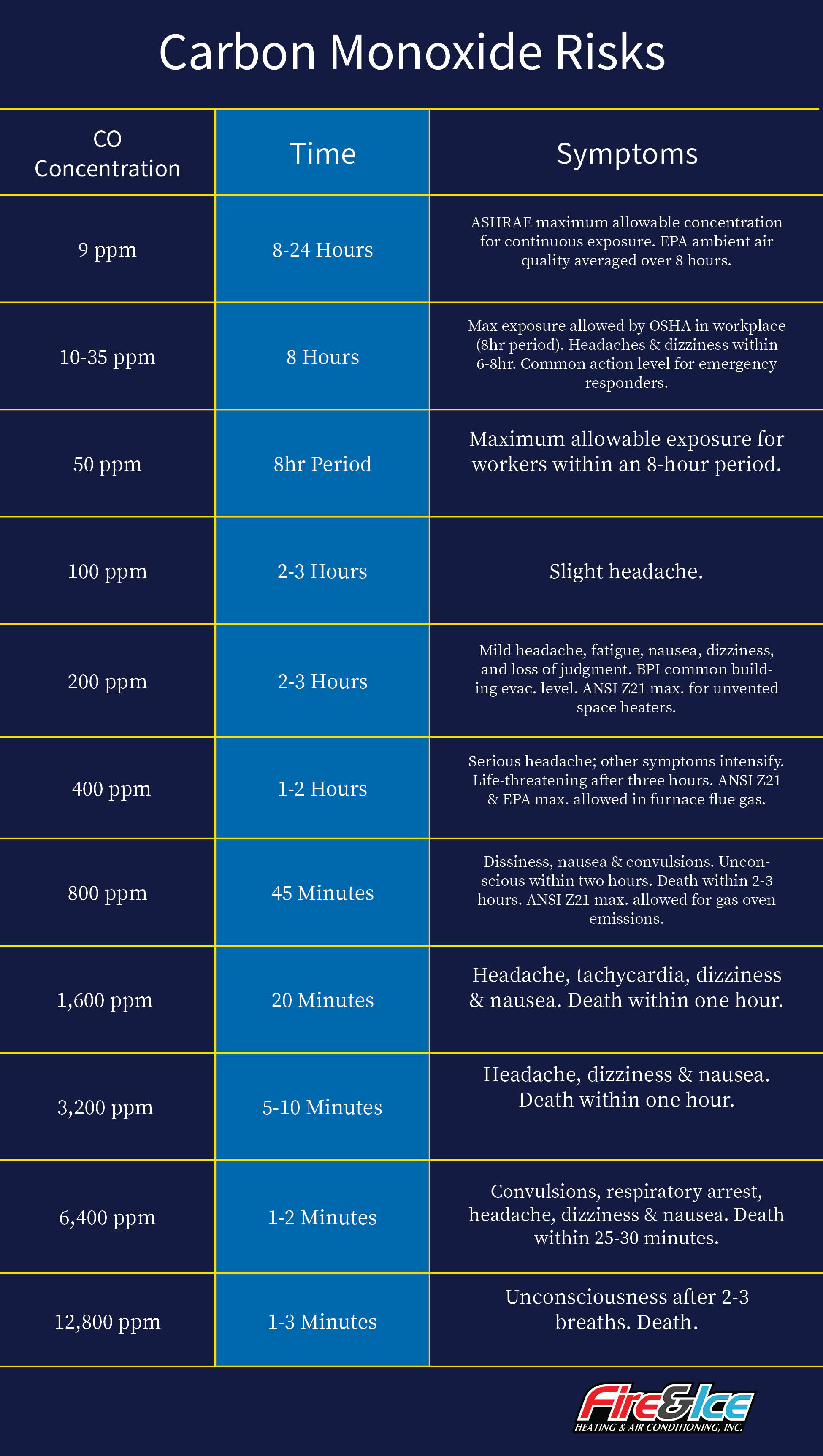


Author:
Revised:
September 30th, 2020
Should you be concerned about carbon monoxide (CO) levels in your home? There are two correct answers to that question.
The first is, “Of course. It’s dangerous.”
The second is, “Not if you’re taking the proper precautions to ensure the safety of you and your family.”
Both of those can be true. We’re going to talk about the risks in this article, but also prepare you to take the proper precautions.
Carbon monoxide is often referred to as “the silent killer.” It is smokeless, odorless, and can’t otherwise be detected by our senses. In high enough doses, it can kill, and even at less-than-lethal levels, there can be serious health risks.
It’s easy to inspire fear when it comes to a topic like carbon monoxide. Rather than try to only come at it from that angle, though, we want to inform you on the topic in a way that will minimize any future risks and give you peace of mind when it comes to your HVAC system.

Areas of Carbon Monoxide Risk
We’re going to focus a lot on HVAC equipment in this article, but that equipment isn’t the only source of CO in your home. Several other items can and will contribute to CO levels. These include:
- Stoves and ovens that use gas fuel
- Gas fireplaces
- Ovens or fireplaces that use wood as fuel
- Your car
- Your dryer unit (assuming it’s in the home)
- Smokers
- Furnaces
- Water heaters
- Portable generators
It’s also important to establish baseline metrics for risk. CO is measured in parts per million (PPM). Anything over a certain threshold can be dangerous, but trace amounts of CO are present in regular air.
For example, one metro area averages 0.03-2.5 parts per million (ppm) averaged over eight hours. These are generally safe levels, and will be similar in most US cities.
Smog alerts are an exception to this. While carbon monoxide isn’t the only harmful chemical that comprises smog, it’s a major component of smog. These conditions can be especially harmful to at-risk populations such as the elderly, very young, or those with respiratory issues, and can contain risks for adults as well.
Those alerts are monitored by city officials, but no such regulating entity exists to protect your home. That’s why it’s your responsibility to ensure the safety of your home, particularly because carbon monoxide will never be as obvious as a smoggy city.
We’re going to talk about carbon monoxide detectors shortly, but in terms of areas you should be aware of, your HVAC equipment (including water heater) is among the likeliest to create house-wide issues if the problem isn’t properly addressed. An HVAC system is a necessity for most homeowners, so it’s worth considering how to prevent danger in the first place.

Symptoms of CO Poisoning
According to the Mayo Clinic, symptoms of CO poisoning include dull headaches, weakness, dizziness, nausea or vomiting, shortness of breath, confusion, blurred vision, and loss of consciousness. Long-term complications include permanent brain damage, damage to your heart (possibly leading to life-threatening cardiac complications), fetal death or miscarriage, and death.
These won’t all happen at once, nor will they happen at all CO levels.
A low level of CO might trigger headaches after a number of hours. The side effects won’t be fatal, and can sometimes be confused for everyday ailments. However, this is still an issue, since even moderate levels of CO should never exist in your home for prolonged periods of time.
Fatal doses of CO tend to occur after several hours. While the highest amounts can be fatal in minutes, even unacceptably high levels in a home will usually require prolonged exposure.
This is the biggest concern while you are sleeping. Since our senses can’t detect CO, this prolonged period is the one that often comes with the greatest risk.

HVAC Best Practices
We’re going to talk about a handful of things a good HVAC contractor can or should do to ensure safety when it comes to CO levels, but most of them come down to two elements: maintenance and proper inspections.
When your system is installed, everything is brand new and you don’t have to worry about CO levels...right? Wrong. Even brand new equipment can be a potential hazard, especially if it’s improperly installed.
So what can be done to prevent this risk? Several things:
- The equipment should be tested for ambient CO levels following installation. This is done in a process called commissioning. If an HVAC contractor is installing a system and leaving immediately after it’s running, this step is being skipped.
- Your chimney flue should be inspected for proper ventilation. Flue liners will periodically need to be replaced, or the chimney might be dirty. Buildup of dirt and grime can be one of the leading causes of rising CO levels. Having your flue repaired or cleaned becomes a necessity in these cases.
- At the time of installation, overall spacing and ventilation should be assessed to ensure that the area has proper ventilation. A buildup in a basement’s mechanical room, for example, is possible when there isn't sufficient ventilation.
- A thorough inspection of all mechanical parts in the system is a good step toward eliminating future risk. Faulty gas valves, inducers, or other parts can be causing a problem, or could contribute to problems down the line if they aren’t proactively maintained.
Commissioning the equipment also establishes baseline metrics for CO levels (among many other performance metrics). When a service technician comes for maintenance, they’ll have this information available. If there is a spike in CO levels at all, even if the levels are still acceptably safe, it may indicate a problem with the equipment.
The ability to check levels at maintenance visits is also important because even a household CO detector isn’t full-proof, as we’ll discuss shortly. Or perhaps the detector is showing no issues near your bedroom, but the true issue resides in the basement. These are all things a trained technician can assist with.
At Fire & Ice, we also include a carbon monoxide detector at no cost when we install a new furnace. Even with the best installation practices, proactive detection is important.
Best Time For Furnace Maintenance
There isn’t a “bad” time to schedule your HVAC maintenance, but we do advise customers to schedule their maintenance before needing the furnace for the first time in the late fall or early winter.
The reason for this is practical: if a problem that exists that could contribute to higher CO levels (or to problems unrelated to CO), it’s best to find out before you need the heat.
Unfortunately, we often find that homeowners wait until something goes wrong to schedule their maintenance. Since this is often after the weather turns cold, it creates a rush on service visits.
By planning in advance to have your system inspected and maintenance, you’ll avoid the delays that sometimes occur during the first cold days of the year.
Moral of the story: don’t play dice with your safety or comfort. Schedule service before you need it.
Carbon Monoxide Detectors
As of January 2017, carbon monoxide detectors are required to be installed in Ohio residences that are newly-constructed one- and two-family homes, townhomes, several types of multifamily housing, and rental units.
Regardless of where you live, state laws regarding CO detectors continue to tighten, making it a necessity to own one in many areas.
CO detectors are a great preventative measure, but they also highlight the importance of HVAC maintenance and commissioning processes. The reason for this is that many carbon monoxide detectors will only trigger when CO levels are already at dangerous levels. Smaller spikes can indicate a growing problem, but won’t necessarily trigger your detector.
For this reason, it’s best to research the level at which your CO detector will trigger, and also follow up with professional inspections at regular intervals.
Fortunately, some newer CO detectors also have a digital readout that will give you the highest CO level that it is detecting. This allows you to have the alarm while also knowing what the levels are in your home, even if they aren’t high enough to trigger the alarm.
Installation & Replacement of CO Detectors
We recommend that you install a brand new carbon monoxide detector once every 3-5 years, rather than just replacing its batteries.
Reason being, some CO detectors have been known to stop working even when the battery power remains. While the technology in this area has improved greatly in recent years, and you can research the expected lifespan of the model you choose, given how inexpensive CO detectors are, this is one area where it’s better to be safe than sorry.
This is doubly true because they’re very easy to install, and don’t require a professional to complete the installation. Generally, it only involves screwing the detector into your ceiling.
And where should you install the CO detector? The best place is close to the bedrooms. As mentioned earlier, it’s these rooms that carry the greatest risk for many homeowners.

Non-HVAC Carbon Monoxide Sources
We discussed some of the other sources of carbon monoxide earlier, and there are steps to take to ensure that these aren’t contributing to your overall CO levels either.
While we don’t service non-HVAC equipment, several best practices exist and are regularly updated by health organizations such as the CDC and EPA. These guidelines include:
- Installing a backup CO detector in your home.
- Never service complicated equipment on your own if you suspect that it is leaking gas.
- Keep indoor fireplaces well-maintained.
- Make sure areas that contain CO-producing items (garages, kitchens, maintenance rooms, etc.) are well-ventilated, especially when the equipment is running.
- If you need to use a generator for a special occasion or emergency, make sure it is properly ventilated as well, and never use it indoors.
- Buy a CO detector with a digital readout for more accurate monitoring.
Other guidelines as prescribed by official regulatory organizations should always be followed.
Be Prepared. Be Safe.
So now that you have some strategies for proactively monitoring your carbon monoxide levels, what’s next?
Only you can answer that question, because it will be specific to the status of your home.
Has it been a couple years since your furnace or water heater was inspected or serviced? Are you installing a new system and unsure of what state your chimney flue is in? When was the last time you changed your CO detector? How many do you have?
The answers to these questions will inform your next steps, and we hope that the information in this article has made it easy to identify what your next step should be.
Carbon monoxide prvention is also just one step in a whole-home plan to prevent risks and injuries. Other resources exist about other unseen or silent risks, such as this article on hidden hazards in your home. Next steps may include incorporating carbon monixide prevention into a larger plan that includes additional items.
Regardless, if that next step involves reaching out to a licensed HVAC contractor, we hope you’ll consider Fire & Ice if you’re in Columbus, Ohio or the surrounding areas. Type in your zip code below to see if you’re in our service area. We look forward to making your day better!

































